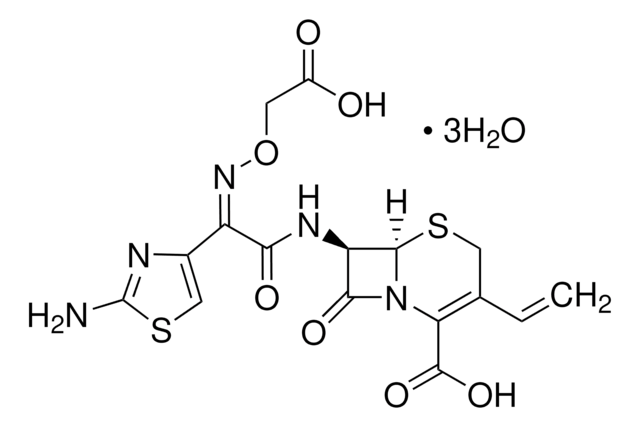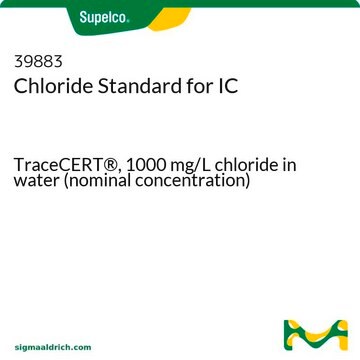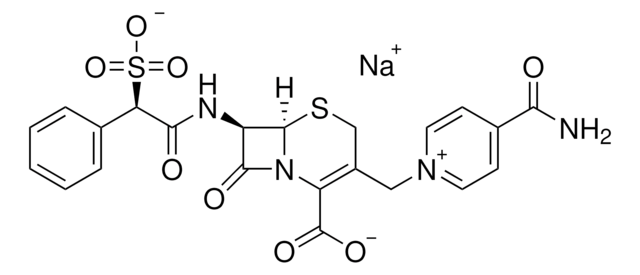18588
Cefixime trihydrate
suitable for microbiology, ≥98.0% (HPLC)
About This Item
Productos recomendados
grade
for ion-selective electrodes
Quality Level
assay
≥98.0% (HPLC)
antibiotic activity spectrum
Gram-negative bacteria
Gram-positive bacteria
application(s)
microbiology
mode of action
cell wall synthesis | interferes
SMILES string
O.O.O.Nc1nc(cs1)C(=N\OCC(O)=O)\C(=O)N[C@H]2[C@H]3SCC(C=C)=C(N3C2=O)C(O)=O
InChI
1S/C16H15N5O7S2.3H2O/c1-2-6-4-29-14-10(13(25)21(14)11(6)15(26)27)19-12(24)9(20-28-3-8(22)23)7-5-30-16(17)18-7;;;/h2,5,10,14H,1,3-4H2,(H2,17,18)(H,19,24)(H,22,23)(H,26,27);3*1H2/b20-9-;;;/t10-,14-;;;/m1.../s1
InChI key
IPYWNMVPZOAFOQ-NABDTECSSA-N
Categorías relacionadas
Application
- Physicochemical parameters and modes of interaction associated with the micelle formation of a mixture of tetradecyltrimethylammonium bromide and cefixime trihydrate: effects of hydrotropes and temperature.: This research delves into the physicochemical behaviors of cefixime trihydrate when mixed with tetradecyltrimethylammonium bromide, focusing on micelle formation and the influence of various hydrotropes and temperature changes on their interaction (Hossain M et al., 2023).
- Development, validation and greenness assessment of a new electro-driven separation method for simultaneous analysis of cefixime trihydrate and linezolid in their fixed dose combination.: This study introduces and validates a novel eco-friendly electro-driven method for analyzing cefixime trihydrate in combination with linezolid, emphasizing its application in fixed-dose pharmaceutical formulations (Habeeb MR et al., 2023).
- Bioremediation of multifarious pollutants using laccase immobilized on magnetized and carbonyldiimidazole-functionalized cellulose nanofibers.: Investigates the efficacy of laccase enzymes, immobilized on specialized cellulose nanofibers, in the bioremediation of pollutants, a process applicable to the environmental management of pharmaceutical agents including cefixime trihydrate (Sharma K et al., 2023).
Analysis Note
Other Notes
related product
signalword
Danger
hcodes
Hazard Classifications
Resp. Sens. 1 - Skin Sens. 1
Storage Class
11 - Combustible Solids
wgk_germany
WGK 3
flash_point_f
Not applicable
flash_point_c
Not applicable
ppe
dust mask type N95 (US), Eyeshields, Faceshields, Gloves
Elija entre una de las versiones más recientes:
Certificados de análisis (COA)
¿No ve la versión correcta?
Si necesita una versión concreta, puede buscar un certificado específico por el número de lote.
¿Ya tiene este producto?
Encuentre la documentación para los productos que ha comprado recientemente en la Biblioteca de documentos.
Los clientes también vieron
Nuestro equipo de científicos tiene experiencia en todas las áreas de investigación: Ciencias de la vida, Ciencia de los materiales, Síntesis química, Cromatografía, Analítica y muchas otras.
Póngase en contacto con el Servicio técnico














